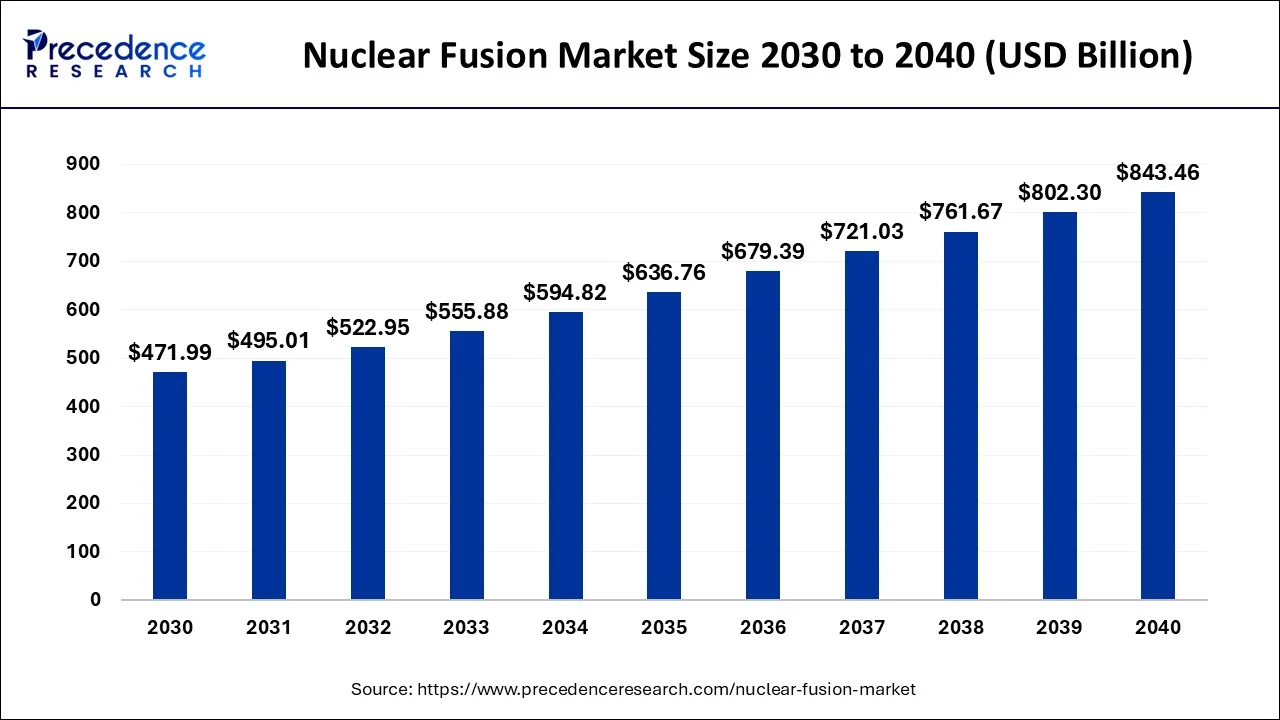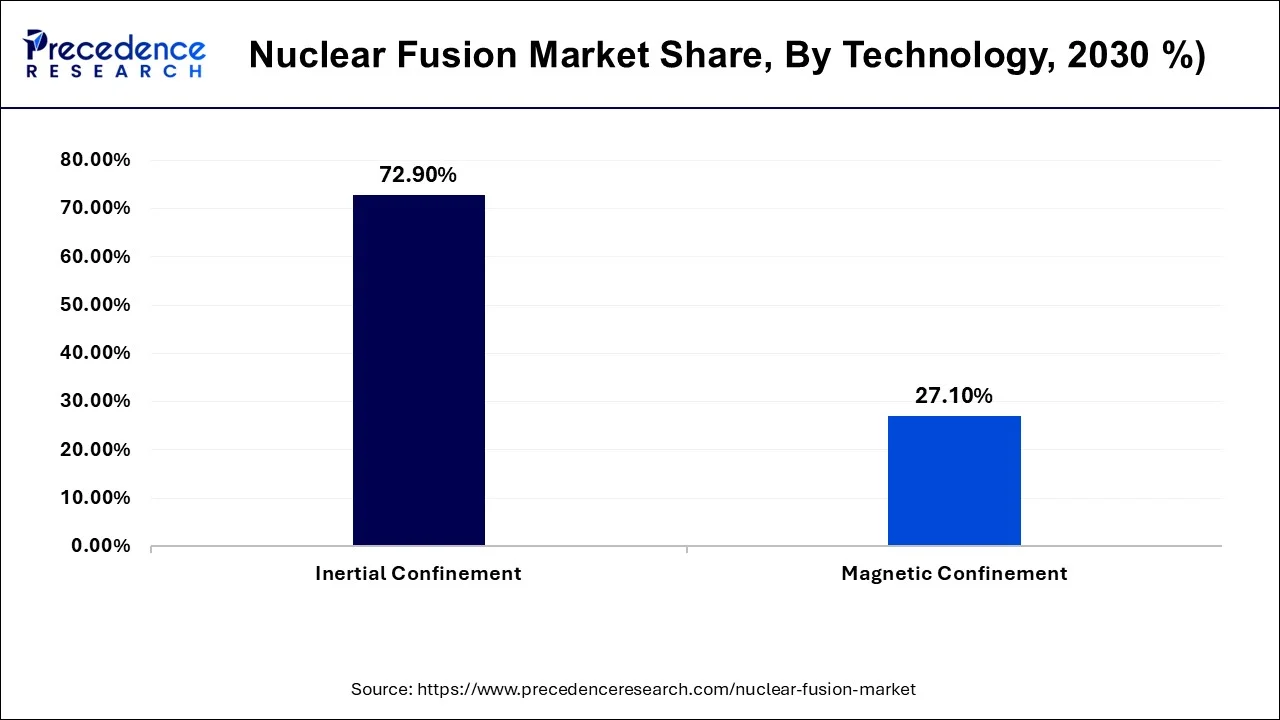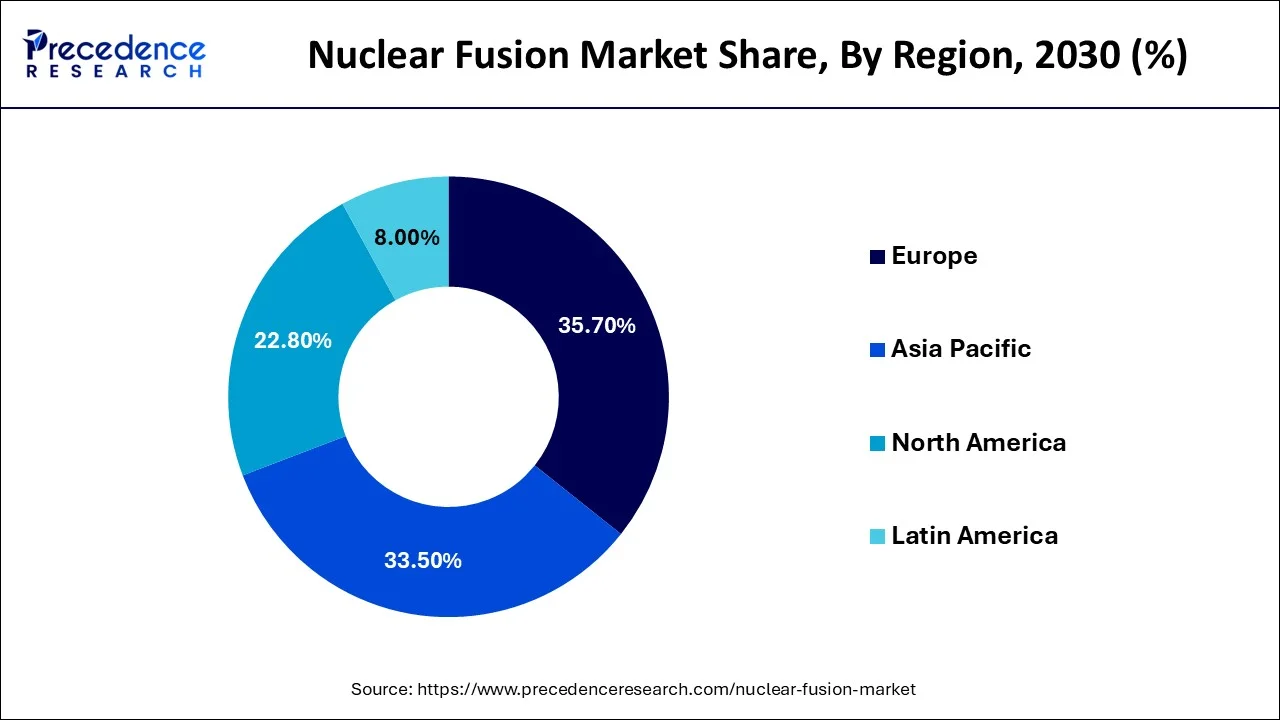List of Contents
Nuclear Fusion Market Size and Forecast 2030 to 2040
The global nuclear fusion market size is expected to be worth around USD 843.46 billion by 2040, and it is growing at a healthy CAGR of 6% during the forecast period from 2030 to 2040.

Key Takeaways
- China nuclear fusion market size is projected to hit around USD 53.68 billion by 2040 and it is growing at a CAGR of 6.4% from 2030 to 2040.
- South Korea nuclear fusion market will reach around USD 38.81 billion by 2040 and it is growing at a CAGR of 6.2% from 2030 to 2040.
- U.S. nuclear fusion market size will hit around USD 203.35 billion by 2040 and is expanding at a CAGR of 5.8% from 2030 to 2040.
- France nuclear fusion market will account revenue USD 100.09 billion by 2040 and it is growing at a CAGR of 6.6% from 2030 to 2040.
- By technology, the inertial confinement fusion segment dominated the nuclear fusion market in 2024.
- By technology, the inertial confinement fusion segment is projected to experience the highest growth rate in the market between 2025 and 2034.
- By Fuels type, the deuterium tritium segment captured a significant share of the market in 2024.
- By Fuels type, deuterium segment is expected to grow at a significant CAGR over the projected period.
Fusion is the sun's power at high temperatures and pressures, atoms collide and "fuse" releasing massive amounts of energy. That means that even small amounts of fuel contain a significant amount of intrinsic energy. That intrinsic energy is released during fusion. Fusion energy is created by pressing atomic nuclei together, breaking the nuclear force that repels atoms from each other and releasing a massive amount of power.
One gramme of fuel can produce 90,000-kilowatt hours of energy. To put it another way, it would take 10 million pounds of coal to produce the same amount of energy as one pound of fusion fuel. Commercial power plants will be able to provide clean, safe, and abundant energy anywhere in the world once science and engineering are proven.
By 2050, the global population will have increased by 33%, and economic growth means that energy demand could be five times higher than it is now. Unfortunately, today's energy system is unsustainable in terms of the environment, economically unstable, and promotes global insecurity. We must meet the world's increasing energy demand while transitioning to clean, affordable, and abundant energy sources. This will necessitate a breakthrough in clean energy technology. However, that breakthrough is not a pipe dream. Fusion is not a science fiction concept. Fusion energy is now routinely produced in laboratories all over the world. Until now, however, each fusion experiment has required more energy to control the fusion reaction than the fusion reaction has released. Commercial fusion will alter the global energy system.
Existing nuclear power plants rely on fission, which is the release of energy when heavy atoms like uranium decay. Fusion, on the other hand, generates energy by fusing very light nuclei, typically hydrogen, which can occur only at extremely high temperatures and pressures. The majority of efforts to harness it in reactors involve heating the hydrogen isotopes deuterium (D) and tritium (T) to form a plasma — a fluid state of matter containing ionized atoms and other charged particles — and then fusing (see 'Fuel mix'). Fusion begins at lower temperatures and densities for these isotopes than for normal hydrogen. Unlike fission, D-T fusion produces some radiation in the form of short-lived neutrons but no long-lived radioactive waste. It is also safer than fission because it can be easily turned off.
Growth Factors
Global population and economic growth, combined with rapid urbanization, will result in a significant increase in energy demand in the coming years. According to the United Nations (UN), the world's population will increase from 7.6 billion in 2017 to 9.7 billion by 2050. The current rate of urbanization, which adds a city the size of Shanghai to the world's urban population every four months or so, will result in roughly two-thirds of the world's population living in urban areas by 2050 (up from 55% in 2018). Meeting rapidly increasing energy demand while reducing harmful glasshouse gas emissions is a significant challenge. Global energy-related carbon dioxide (CO2) emissions reached 33.3 Gt in 2019, the highest level on record and roughly 45% higher than in 2000. (23.2 GT). Because of the coronavirus pandemic response, primary energy demand fell by nearly 4% in 2020, while CO2 emissions fell by 5.8%. For many years, the growth of electricity demand has outpaced the growth of final energy demand.
Increased electrification of end-uses such as transportation, space cooling, large appliances, ICT, and others is a major contributor to rising electricity demand. The number of people without access to electricity has decreased significantly and is now below one billion. Despite significant progress, over 11% of the world's population still lacks access, primarily in rural areas. The European Commission (EC) issued a policy paper titled Energy 2050 Roadmap in December 2011. This was very positive about nuclear power, stating that it can make "a significant contribution to the energy transformation process" and is "a key source of low-carbon electricity generation" that will keep system costs and electricity prices low. "Nuclear energy will remain in the EU power generation mix as a large-scale low-carbon option." The paper examined five scenarios that could lead to the EU's low-carbon energy economy goal of 80% CO2 reduction by 2050, based on energy efficiency, renewables, nuclear power, and carbon capture and storage (CCS). All scenarios show that electricity will have to play a much larger role than it does now, nearly doubling its share of final energy consumption.
Global energy demand is expected to skyrocket over the next few decades. This is primarily due to projected global population growth as well as the economic and industrial growth of developing countries such as China and India. Nuclear power is still needed for a variety of reasons, including the need for reliable baseload electricity and the threat of global climate change. Nuclear power, as the only large-scale source of nearly carbon-free energy, is an essential component of our all-of-the-above energy strategy, generating about 60% of low-carbon energy. Nuclear energy, rather than chemical burning, generates baseload electricity with no output of carbon, the villainous component of global warming. Switching from coal to natural gas is a step towards decarbonization because natural gas produces half the carbon dioxide that coal does. However, switching from coal to nuclear power is radically decarbonizing because nuclear power plants emit glasshouse gases only from the ancillary use of fossil fuels during construction, mining, fuel processing, maintenance, and decommissioning roughly the same as solar power, which emits about 4 to 5 per cent as much as a natural gas-fired power plant.
Nuclear Fusion Market Scope
| Report Coverage | Details |
| Forecast Period | 2030 to 2040 |
| Segments Covered | Technology, Fuels |
| Regions Covered | North America, Europe, Asia Pacific, Latin America, and MEA |
Restraint
One of the most significant restraints in the nuclear fusion market is the extremely high capital investment required to design, build, and operate fusion facilities. Unlike conventional energy plants, fusion reactors demand advanced materials capable of withstanding extreme temperatures and neutron bombardment, along with precision engineering for plasma confinement systems. The construction of large scale projects such as ITER involves multi-billion dollar budgets, extended timelines spanning decades, and contributions from multiple governments and private investors. These immense upfront costs deter smaller players from entering the market and make it challenging for start-ups to transition from laboratory scale experiments to commercially viable power plants.
Additionally, financing complexities slow progress even for established projects. Fusion research requires sustained funding over long development cycles, but investment timelines often clash with political election cycles and private sector demands for near term returns. Changes in government priorities or funding allocations can stall projects mid development, leading to costly delays and redesigns. As a result, the industry risks being trapped in a cycle where high costs limit competition, and limited competition slows down innovation and cost reduction reinforcing the restraint.
Despite decades of research, nuclear fusion has not yet reached the point of consistent net energy gain in a commercially deployment format, creating significant technological uncertainty. Achieving and sustaining the extreme plasma conditions temperatures exceeding 100 million degrees Celsius requires precise control and stability, and even minor deviations can lead to major risk for investors, as no single technological pathway (magnetic confinement, inertial confinement, or alternative methods) has been proven at utility scale. Without a clear “winning” technology, market participants face difficulty in committing resources to large scale deployment strategies.
Furthermore, the inherently long timelines to bring fusion technology to market amplify the uncertainty. While recent breakthroughs have narrowed the gap to commercialization, most experts still anticipate a decade or more before fusion plants contribute meaningfully to the grid. This extended horizon creates an innovation bottleneck, as companies must sustain Research and development without immediate revenue streams, while competing energy technologies such as advanced nuclear fission, solar, and wind continue to improve and attract investment. For many potential stakeholders, the combination of citify complexity and slow commercialization dampens enthusiasm, creating a formidable restraint to market expansion.
Technology Insights
The interatrial confinement fusion segment dominated the market in 2024. This dominance stems from its potential to deliver extremely high energy densities in compact facilities, making it attractive for research institutions and commercial pilot projects. The method, which uses powerful lasers or particle beams to compress and heats fusion fuel to the necessary conditions for ignition, has gained momentum due to large scale projects and significant funding from both public and private sectors. Advances in laser efficiency, pallet design, and diagnostic systems have further enhanced its commercial viability, enabling the segment to maintain a strong position in the nuclear fusion market.
The inertial confinement fusion segment is projected to experience the highest growth rate in the market between 2025 and 2034. Rapid advancements in high energy laser systems, combined with innovations in target fabrication and plasma diagnostics, are expected to accelerate the path toward sustained energy output. Additionally, collaborations between national laboratories, universities, and private fusion companies are creating a fertile environment for commercialization. This segment's growth is also supported by the scalability of the technology for both power generation and niche high energy applications.

Celsius are reached during the process. Magnetic fields are ideal for confining a plasma because the separated ions and electrons follow the magnetic field lines due to their electrical charges. The goal is to keep the particles from colliding with the reactor walls, which would dissipate their heat and slow them down. The most efficient magnetic configuration is toroidal, which is shaped like a doughnut and has the magnetic field curved around to form a closed loop. This toroidal field must have a perpendicular field component superimposed on it for proper confinement (a poloidal field). The result is a magnetic field with spiral (helical) force lines that confine and control the plasma.
Fuel Insights
The deuterium tritium segment captured a significant portion of the market in 2024. This combination remains the preferred choice for most experimental fusion reactors due to its relatively high reaction cross section, enabling fusion at comparatively lower temperatures than alternative fuels. The availability of deuterium from sweater and the potential to breed tritium for lithium inside the reactor make this fuel cycle particularly appealing for sustained operations. Furthermore, many flagship projects such as ITER and various private sector reactors are optimized for deuterium tritium fuel, reinforcing its dominant position in ongoing developments.
The deuterium segment is projected to expand rapidly in the market in the coming years. While it requires higher temperatures to achieve fusion compared to deuterium tritium, it offers the advantage of producing fewer radioactive by-products and eliminating the dependence on tritium breeding. This makes it attractive from both environmental and safety standpoints. Ongoing research into advanced confinement systems and plasma heating methods could make deuterium fusion viable, opening up pathways for cleaner and potentially more sustainable commercial fusion energy production in the long term.
Regional Insights
According to an October survey by the Fusion Industry Association (FIA) in Washington DC, which represents companies in the sector, there are now more than 30 private fusion firms globally; the 18 firms that have declared their funding say they have attracted more than US$2.4 billion in total, almost entirely from private investments (see 'Fusion funding'). Advances in materials research and computing, which enable technologies other than the standard designs pursued by national and international agencies for so long, are critical to these efforts.

Europe is at the forefront of fusion energy research. Nuclear fusion could become the primary source of energy in the second half of this century, and Europe is well-positioned to lead the way if its resources are managed properly. EURO fusion, a new initiative that will pool fusion research in Europe, will be officially launched on October 9th. 'Because we have such a broad and well-organized fusion programmed, Europe has the opportunity to strengthen its world-leading position here.
Excellent nuclear fusion technology activities are also being carried out in APAC. After superheating a loop of plasma to temperatures five times hotter than the sun for more than 17 minutes, China's "artificial sun" established a new world record. The experimental advanced superconducting tokomaks (EAST) nuclear fusion reactor reportedly maintained a temperature of 158 million degrees Fahrenheit (70 million degrees Celsius) for 1,056 seconds, according to the Xinhua News Agency.
Australia, New Zealand (Oceania)
Oceania encompassing Australia and New Zealand, presents a compelling case to be treated as distinct region in nuclear fusion market analysis. Australia has positioned itself as a leader in advanced energy research, supported by a network of world class unitive cities, national laboratories, and government backed innovation programs. Its abundant reserves of lithium and other critical minerals create a natural advantage for fusion fuel cycles, while its strong regulatory framework and stable political climate make it attractive for long term energy infrastructure investment. New Zealand, though smaller in scale, is fostering a dynamic clean tech ecosystem, leveraging its commitment to renewable energy and active participation in international research collaborations. Together, these nations offer a unique blend of resource security, technological expertise, and pro innovation policy environments. Recognizing Oceania as a standalone region rather than subsuming it into Asia Pacific allows for clearer strategic focus, more accurate market sizing, and targeted opportunity mapping for stakeholders in the global nuclear fusion industry.

Key Market Developments
- In July 2025, Helion Energy has started building a nuclear fusion power plant in Malaga, Washington, aimed at powering Microsoft data centres by 2028. The project repurposes technology from its Polaris prototype into the new Orion reactor, pending final state permitting.
(Source: Helion Energy starts construction on nuclear fusion plant to power Microsoft data centers | Reuters) - In June 2025, MIT's Plasma Science Fusion Centre unveiled the Schmidt Laboratory for Materials in Nuclear Technologies (LMNT), accelerating testing and development of advanced materials capable of withstanding extreme fusion environments critical for the rapid commercialization of fusion power.
(Source: New facility to accelerate materials solutions for fusion energy | MIT News | Massachusetts Institute of Technology)
Nuclear Fusion Market Companies
- Zap Energy
- First Light Fusion
- General Fusion
- TAE Technologies
- Commonwealth Fusion
- Tokamak Energy
- Lockheed Martin
- Hyperjet Fusion
- Marvel Fusion
- Helion
- HB11
- Agni Fusion Energy
Segments covered in the report
By Technology
- Inertial Confinement
- Magnetic Confinement
By Fuels
- Deuterium/tritium
- Deuterium
- Deuterium, helium-3
- Proton Boron
By Geography
- North America
- U.S.
- Canada
- Europe
- U.K.
- Germany
- France
- Asia-Pacific
- China
- India
- Japan
- South Korea
- Malaysia
- Philippines
- Latin America
- Brazil
- Rest of Latin America
- Middle East & Africa (MEA)
For inquiries regarding discounts, bulk purchases, or customization requests, please contact us at sales@precedenceresearch.com
Frequently Asked Questions
Ask For Sample
No cookie-cutter, only authentic analysis – take the 1st step to become a Precedence Research client